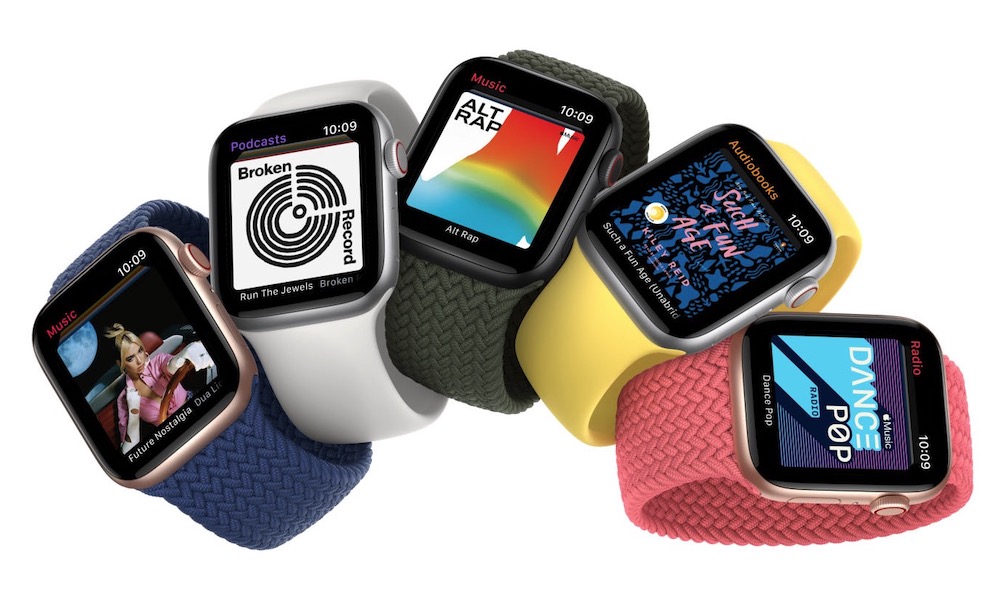There’s Now an Apple Watch on 100 Million Wrists Following the Launch of Apple Fitness+
 Credit: Apple
Credit: Apple
Toggle Dark Mode
The Apple Watch recently passed a pretty significant milestone, with analysts estimating that there are now 100 million Apple Watches in active use around the world.
The data comes from Neil Cybart at Above Avalon, who notes that Apple crossed the 100-million mark just this past December, following the launch of Apple Fitness+, which he credits along with several other new initiatives by Apple that have helped to push the wearable even more into the mainstream.
Chief among these are the introduction of a second, more affordable Apple Watch SE, the new Family Setup feature that debuted in iOS 14 and watchOS 7 last fall, and other features such as blood oxygen monitoring and cardio fitness improvements, all of which combine to make the device more appealing to an even wider range of users.
In fact, Family Setup along has likely driven more Apple Watch adoption than any other single feature, since it’s untethered the wearable from the iPhone even further, allowing the Apple Watch to be given to kids, spouses, or other family members who may not otherwise want or be able to use an iPhone.
This one move increased the market for the Apple Watch, and of course, the debut of the lower-cost SE model played right into that as well.
Cybart noted early last year that the Apple Watch had already “ushered in a paradigm shift in computing,” at a time when only 65 million devices were estimated to be in use worldwide, explaining that the view that the Apple Watch is “nothing more than an iPhone accessory,” is misplaced, suggesting that it’s this misunderstanding of what the wearable device is all about that accounts for the failure of many of Apple’s competitors to release a similarly compelling product.
Growth Is Accelerating
According to Cybart’s latest analysis, the market growth of the Apple Watch has been rapidly accelerating, noting that its “growth trajectory has not been constant or steady over the years,” but is continuing to accelerate as the device gains critical mass.
In fact, 30 million new people began wearing an Apple Watch in 2020 alone, beating out the new number of new Apple Watch users in 2015, 2016, and 2017 combined — the first three years of its availability.
The analysis also goes on to compare the adoption of the Apple Watch to the installed base of iPhone users — a number that now exceeds one billion active devices.
Basic math reveals that this means about 10 percent of iPhone users also own an Apple Watch, since except for Family Setup — a niche group that’s likely confined mostly to younger children and older adults — an iPhone is required to use an Apple Watch.
More importantly, however, this represents the market potential for the Apple Watch, since even Family Setup still requires the Apple Watch to be set up using an iPhone, so it’s essentially just one iPhone user buying an additional Apple Watch.
What’s notable here is that Cybart concedes that the Apple Watch isn’t going to be suited to every iPhone user, and therefore highlights 10 percent adoption as an impressive number, but that’s even more noteworthy is that the adoption has been strongest in the U.S., where 35 percent of iPhone users are now believed to be wearing an Apple Watch.
However, this also suggests a lot of growth potential. For example, if that same 35 percent adoption was taken up globally, the installed base would grow to 2.5 times what it is right now. Cybart also suggests that Apple could increase its market by opening the wearable up to competing smartphone platforms, since he believes that “the Apple Watch’s future is one of true independency from the iPhone.”
At the current sales trajectory, the Apple Watch installed base will surpass the Mac installed base in 2022.
Neil Cybart, analyst, Above Avalon
More significantly is that the Apple Watch now has the fourth-largest install base among Apple’s products, naturally trailing behind the iPhone, iPad, and Mac, but based on the current sales trajectory, it’s expected that by 2022 it will actually be more popular than the Mac, although it could be a few more years before it begins to eclipse the iPad — at least based on current trends.







